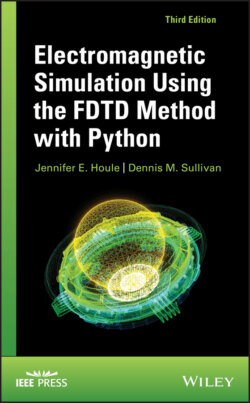Electromagnetic Simulation Using the FDTD Method with Python

Реклама. ООО «ЛитРес», ИНН: 7719571260.
Оглавление
Dennis M. Sullivan. Electromagnetic Simulation Using the FDTD Method with Python
Table of Contents
List of Tables
List of Illustrations
Guide
Pages
ELECTROMAGNETIC SIMULATION USING THE FDTD METHOD WITH PYTHON
ABOUT THE AUTHORS
PREFACE
GUIDE TO THE BOOK
FORMAT
SPECIFIC CHOICES DEALING WITH SOME TOPICS
Z TRANSFORMS
PROGRAMMING EXERCISES
PROGRAMMING LANGUAGE
PYTHON VERSION
1 ONE‐DIMENSIONAL SIMULATION WITH THE FDTD METHOD
1.1 ONE‐DIMENSIONAL FREE‐SPACE SIMULATION
PROBLEM SET 1.1
1.2 STABILITY AND THE FDTD METHOD
PROBLEM SET 1.2
1.3 THE ABSORBING BOUNDARY CONDITION IN ONE DIMENSION
PROBLEM SET 1.3
1.4 PROPAGATION IN A DIELECTRIC MEDIUM
PROBLEM SET 1.4
1.5 SIMULATING DIFFERENT SOURCES
PROBLEM SET 1.5
1.6 DETERMINING CELL SIZE
PROBLEM SET 1.6
1.7 PROPAGATION IN A LOSSY DIELECTRIC MEDIUM
PROBLEM SET 1.7
1.A APPENDIX
REFERENCES
PYTHON PROGRAMS USED TO GENERATE FIGURES IN THIS CHAPTER
2 MORE ON ONE‐DIMENSIONAL SIMULATION
2.1 REFORMULATION USING THE FLUX DENSITY
PROBLEM SET 2.1
2.2 CALCULATING THE FREQUENCY DOMAIN OUTPUT
PROBLEM SET 2.2
2.3 FREQUENCY‐DEPENDENT MEDIA
2.3.1 Auxiliary Differential Equation Method
PROBLEM SET 2.3
2.4 FORMULATION USING Z TRANSFORMS
2.4.1 Simulation of Unmagnetized Plasma
PROBLEM SET 2.4
2.5 FORMULATING A LORENTZ MEDIUM
2.5.1 Simulation of Human Muscle Tissue
PROBLEM SET 2.5
REFERENCES
PYTHON PROGRAMS USED TO GENERATE FIGURES IN THIS CHAPTER
3 TWO‐DIMENSIONAL SIMULATION
3.1 FDTD IN TWO DIMENSIONS
PROBLEM SET 3.1
3.2 THE PERFECTLY MATCHED LAYER (PML)
PROBLEM SET 3.2
3.3 TOTAL/SCATTERED FIELD FORMULATION
3.3.1 A Plane Wave Impinging on a Dielectric Cylinder
3.3.2 Fourier Analysis
PROBLEMS SET 3.3
REFERENCES
4 THREE‐DIMENSIONAL SIMULATION
4.1 FREE‐SPACE SIMULATION
PROBLEM SET 4.1
4.2 THE PML IN THREE DIMENSIONS
PROBLEM SET 4.2
4.3 TOTAL/SCATTERED FIELD FORMULATION IN THREE DIMENSIONS
4.3.1 A Plane Wave Impinging on a Dielectric Sphere
PROBLEM SET 4.3
REFERENCES
5 ADVANCED PYTHON FEATURES
5.1 CLASSES
PROBLEM SET 5.1
5.1.1 Named Tuples
5.2 PROGRAM STRUCTURE
5.2.1 Code Repetition
PROBLEM SET 5.2.1
5.2.2 Overall Structure
PROBLEM SET 5.2.2
5.3 INTERACTIVE WIDGETS
PROBLEM SET 5.3
6 DEEP REGIONAL HYPERTHERMIA TREATMENT PLANNING
6.1 INTRODUCTION
6.2 FDTD SIMULATION OF THE SIGMA 60
6.2.1 Simulation of the Applicator
6.2.2 Simulation of the Patient Model
6.3 SIMULATION PROCEDURE
6.4 DISCUSSION
REFERENCES
APPENDIX A THE Z TRANSFORM
A.1 THE SAMPLED TIME DOMAIN AND THE Z TRANSFORM
A.1.1 Delay Property
A.1.2 Convolution Property
A.2 EXAMPLES
A.3 APPROXIMATIONS IN GOING FROM THE FOURIER TO THE Z DOMAIN
PROBLEM SET A
REFERENCES
APPENDIX B ANALYTIC SOLUTION TO CALCULATING THE ELECTRIC FIELD
REFERENCE
Index
WILEY END USER LICENSE AGREEMENT
Отрывок из книги
IEEE Press 445 Hoes Lane Piscataway, NJ 08854
.....
From this we can get the computer equations
(1.16a)
.....